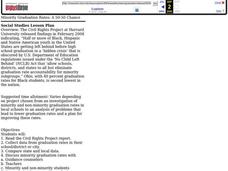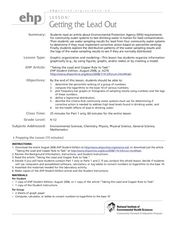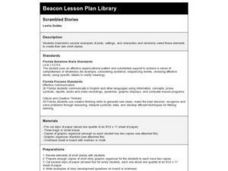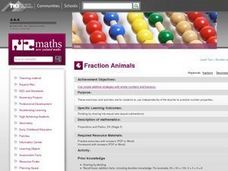Curated OER
Fix It
Word processing practice and vocabulary blend with proofreading in a multi-purpose lesson plan that makes excellent use of an hour in the computer lab. Learners edit the grammatical, spelling, and punctuation errors in a given paragraph...
Curated OER
Minority Graduation Rates: A 50-50 Chance
Students read the Civil Rights Project report. Students collect data from graduation rates in their school/district or city. Students compare state and local data. Students discuss and analyze minority graduation rates. Students compare...
Curated OER
Pair Editing
Practice thinking critically and editing by finding basic errors in spelling, punctuation, and grammar. Partners read the stories What's Up? and Cold Water Clean. They look for and edit any mistakes they find. Worksheets are available...
Curated OER
Literary Elements in Of Mice and Men
Ninth graders review an exercise, after reading most of the novel Of Mice and Men by John Steinbeck. They demonstrate a range of literary elements such as conflict, symbolism, setting, and foreshadowing. Students also are able to provide...
Curated OER
Research Skills: Evaluating Information and Sources
While this focuses on Ancient Rome, the objectives are improved research and information evaluation skills. In one class period, class members narrow their topic, research it, select the best information, log useful sources, and discuss...
Curated OER
Locating IIT Using Ordered Pairs
Students investigate ordered pairs. In this math activity, students plot and locate ordered pairs in a coordinate plane and are exposed to how to read and create a map.
Curated OER
Acrostic Book Report
Learners read the story Wild Horse Winter and construct acrostic poems. In this poetry lesson, students use adjectives and events in the text to develop an acrostic poem.
Curated OER
Introducing Communication Talent with "Casey at the Bat"
Analyze the poem "Casey at the Bat." Your team of analysts will read the poem and complete a variety of activities, including describing how Casey looks and acts, describing how he feels before and after he strikes out, and sharing...
Curated OER
Getting the Lead Out
The article for this lesson no longer accessible through the links in the lesson plan, but can be found in the National Center for Biotechnology Information website. After reading it, environmental science students answer questions and...
Curated OER
Examining What Sharing Really Means
After reading "The Senegalese Miracle" about the degree of sharing the author encounters upon arrival in Africa, class members read Mike Tidwell’s “Sharing in Africa” and compare the two stories. This cultural diversity lesson concludes...
Curated OER
The Extra Place Lesson
Students explore communication skills. In this Peace Corps lesson, students read "The Extra Place," by Susan Peters and discover Polish cultural traditions. Students consider how they would respond in a scenario that challenges their...
Curated OER
Waking Up, Stepping Out
Learners examine cultural differences. In this Peace Corps lesson, students compare their culture to Nepali culture as they read and discuss Waking Up, Stepping Out by Steve Iams.
Curated OER
3-D Figures Part 1
Elementary schoolers explore 3-D shapes. They transition from thinking of shapes as only 2-D. Pupils read Cinderella as a launching activity for their upcoming adventure, and explore a new world of 3-D shapes in this introductory lesson.
Curated OER
Water in Africa
Students discover the horrible situation of water shortages that many people face by completing Peace Corps activities. In this global health lesson, students analyze and discuss photographs of people in Africa struggling to find...
Curated OER
Deep Gardens
Marine biology beginners read about the 2005 Florida Coast Deep Corals expedition, research phylum Cnidaria, and then report on a specific coral deep-sea coral group. There is an abundance of background information and internet resources...
Curated OER
Native Design Coil Vase: Ceramics Lesson
After a quick study of Native American art, symbolism, and pattern design children make a ceramic vase. They read about the use, production, and design of Native American vases or pots, then use clay to create one of their own. Tip:...
Curated OER
Add and Subtract Equations with Equal Sign
Gain exposure to addition and subtraction symbols. First, pupils examine a visual number sentence (featuring Sponge Bob), filling in the correct symbol to make it a complete equation. Next, they read a run-on number sentence involving...
Curated OER
Scrambled Stories
Character development, setting, and plot? Sounds like the makings of a good narrative story. Young authors read and analyze several narrative examples, and then they use what they know to pen an original composition. They work both in...
Curated OER
For the Fun of It
Students view pictures of Amelia Earhart and discuss the social and historical context of her life. They read excerpts of Earhart's autobiography "The Fun of It" and analyze her purpose in writing it.
Curated OER
Community & Architecture
Learners investigate the Bamum people of Cameroon and the use of symbols in African societies. They read a handout, and design a palace using African symbols, presenting and describing their design to the class.
Curated OER
What Happened?
Students read legends about volcanoes. They develop their own legend and shares them with the class. They practice their writing skills as well.
Curated OER
One Event: Different Perspectives
Students watch a video clip from "The Path to 9/11" and write a summary of one of the events depicted. Next, they read the 9/11 Commission Report to compare information from the report to that of the media clip. They chose one more print...
Curated OER
Fraction Animals
Second, third, and fourth graders explore fraction strategies and division by splitting sets of farm animals into equal numbers. Independently, they read word problems, solve them, and check their answers.
Curated OER
Ratio and Proportion: Basic Operations and Applications
Learners explore example problems dealing with ratios and proportions. Afterward, they read story problems and solve them using ratios and proportions. This four-page worksheet contains six multi-step problems.























